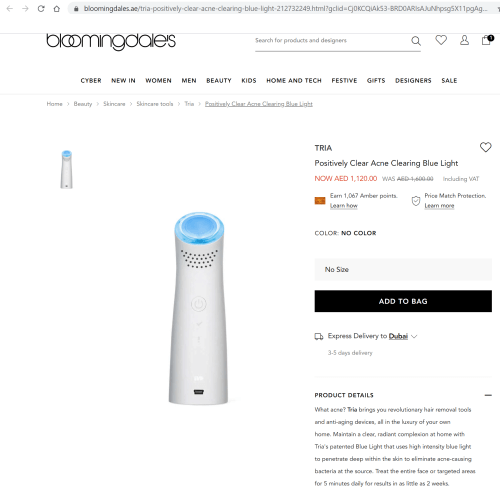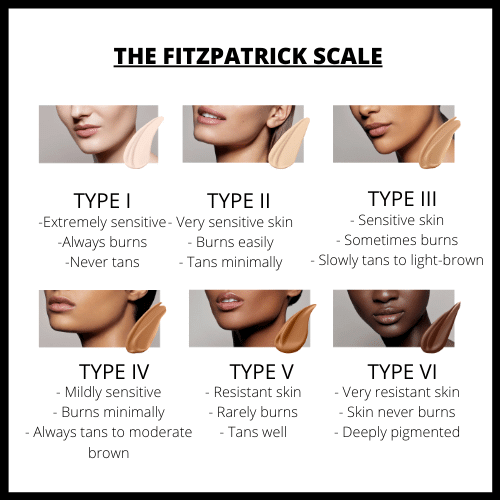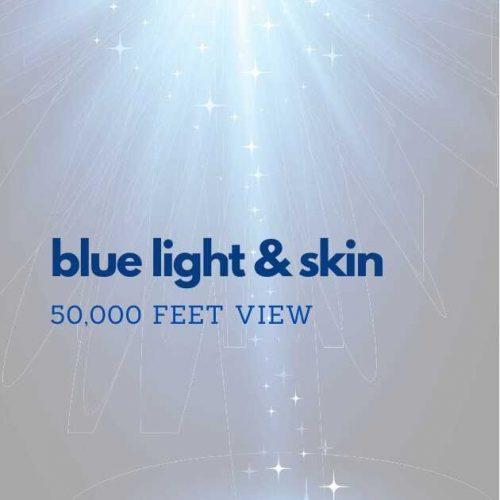My close friend is a mother of two and works about 10-12 hours a day. Her feedback on some of blogs is insightful: she wants to know about blue light but she doesn’t want to read more than 500 words on it.
At least she’s generous on the word count.
This is a blue light 101 blog and what follows, are more detailed blogs on specific issues.
Q1) What is Blue Light?
Technically, its Visible Light (that which illuminates things and enables us to see) is what you are interested in. But Blue Light and Red Light are most frequently encountered.

Q2) Is Blue Light and skincare a thing?
Yes, it is. I love this photo because it shows that Blue light does penetrate the top layer of the skin.

Secondly, blue light technology is used to treat (e.g.) acne, dermatitis, rosacea, pre-cancerous lesions etc. Blue light is effective because of its anti-inflammatory and anti-proliferative properties. Many home-use skincare tools use blue light, such as this Tria device below

Red light technology is also used for skincare, especially as anti-aging device, skin resurfacing etc.
Q3) Why do I see skincare products that are offering protection against blue light+IR+UV?
Solar radiation from the sun is a spectrum from UVR through Visible Light through to Infra-Red.
UVB radiation is very energetic and is associated with (e.g.) redness (erythema) and skin cancer.
There are decades of research on the deleterious effects of UV radiation.

However, its only recently (and I mean in the past 5-10 years) that attention has shifted to Visible Light.
Visible Light does have a biological effect on the skin. This is why you see products that are proposing to protect against Visible Light.
BUT
The amount of research on Visible Light is not there yet, especially around long-term effects of Visible Light exposure. Many of the clinical trials are using intense Visible light sources, which are not the parameters of real-life. Also, none of the studies that I saw are over long-periods of time. Therefore, you cannot know the efficacy of a product/ingredient without data….
Q4a) What are the deleterious effects of Visible Light?
I write Visible Light, but it may just be Blue Light, because Red Light is not implicated in causing pigmentation below.
Deleterious effects are:
– Does cause erythema (redness) in the skin
– Does cause pigment changes in darker skinned individuals (Fitzpatrick III-IV) and this pigmentation has more staying power as well as is darker (and this was in comparison to UVA radiation). Blue light does not appear to have the same impact on pigmentation in Fitzpatrick Type II.

– Produces Reactive Oxygen Species, which ages the skin (and indirectly) causes DNA damage
CAVAET: A major cavaet to all the studies on increased pigmentation is that they maybe using devices that produce Visible Light (and therefore) Blue Light of greater intensity than is experienced in normal life.
Q4b) How about Red Light?
It appears that Blue Light has the deleterious impact on pigmentation but not red light.
Q5) How is Visible Light really different from UV radiation?
Obviously, Visible Light is not causing skin cancer – UV radiation has been convincingly implicated in this.
From my perspective, the mechanism for the synthesis of melanin by Blue Light is different than UVB and UVA. This is a really big deal for future product development, because its almost the Holy Grail for skincare products.
Q6) Does sitting in front of a computer for 8 hours increase pigmentation?
The clinical studies on this are limited. However, a clinical trial involving 8 hours of exposure for 5 days to an intense LED screen did not worsen melasma (which is a pigmentation disorder).
Other devices such as TV screen, computer monitor, mobile phone do not have a known effect on pigmentation at this time. In English this means, we don’t know enough.
Q7) What products are there that protect against Blue Light?
There are 3 categories: anti-oxidants, sunscreens and zinc oxide
A 3.2% Zinc Oxide emulsion has been shown to be effective. Many products (especially tinted sunscreens) now contain Zinc Oxide. However, 3.2% is very specific. Good luck finding that on the market.
With respect to sunscreens, it appears to non-micronized / non-nano sunscreens containing Zinc Oxide and/or Titanium Dioxide do protect against Blue Light. It literally has to be white on your skin. Even if you do find this on the market, let me know how you feel walking around like a sheet. More on this later.
Anti-oxidants and sunscreen: There are indications that anti-oxidants contained in sunscreens may counter damage caused by visible light. I am not sure I am persuaded by the data, so I’ll write about this.
Closing: More on all of the above later. But this is the absolute bare minimum that you need to know about blue light…
****
Sources and uses
Ramasubramaniam R et al (2011) Are there mechanistic differences between ultraviolet and visible radiation induced skin pigmentation? Photochem Photobiol Sci 10(12):1887–1893
Haywood R (2006) Relevance of sunscreen application method, visible light and sunlight intensity to free-radical protection: a study of ex vivo human skin. Photochem Photobiol 82(4):1123–1131
Mahmoud BH et al (2008) Effects of visible light on the skin. Photochem Photobiol 84(2):450–462
Duteil L et al (2014) Differences in visible light-induced pigmentation according to wavelengths: a clinical and histological study in comparison with UVB exposure. Pigment Cell Melanoma Res 27(5):822–826
Rijken F et al, The protective effect of sunscreens, vitamin E 6% cream, and betamethasone 0.1% cream on solar-simulating radiation-induced erythema and neutrophil influx, Journal of the American Academy of Dermatology, Volume 68, Issue 3, 2013, Pages 512-513
Alexis B. Lyons et al , Photoprotection beyond ultraviolet radiation: A review of tinted sunscreens, Journal of the American Academy of Dermatology, 2020
Regazzetti C et al Melanocytes Sense Blue Light and Regulate Pigmentation through Opsin-3. J Invest Dermatol. 2018 Jan;138(1):171-178. doi: 10.1016/j.jid.2017.07.833. Epub 2017 Aug 24. PMID: 28842328.
Kohli I et al Impact of Long-Wavelength Ultraviolet A1 and Visible Light on Light-Skinned Individuals. Photochem Photobiol. 2019 Nov;95(6):1285-1287. doi: 10.1111/php.13143. Epub 2019 Aug 23. PMID: 31344760.
Boukari F et al, Prevention of melasma relapses with sunscreen combining protection against UV and short wavelengths of visible light: A prospective randomized comparative trial, Journal of the American Academy of Dermatology, Volume 72, Issue 1, 2015, Pages 189-190.e1
Castanedo‐Cazares J P et al, Near‐visible light and UV photoprotection in the treatment of melasma: a double‐blind randomized trial https://doi.org/10.1111/phpp.12086
Bissonnette R et al Protection afforded by sunscreens containing inorganic sunscreening agents against blue light sensitivity induced by aminolevulinic acid. Dermatol Surg. 2008 Nov;34(11):1469-76. doi: 10.1111/j.1524-4725.2008.34311.x. Epub 2008 Sep 15. PMID: 18798755.
Martini APM Influence of visible light on cutaneous hyperchromias: Clinical efficacy of broad-spectrum sunscreens. Photodermatol Photoimmunol Photomed. 2018 Jul;34(4):241-248. doi: 10.1111/phpp.12377. Epub 2018 Mar 22. PMID: 29381828.
Schalka S, A novel method for evaluating sun visible light protection factor and pigmentation protection factor of sunscreens. Clin Cosmet Investig Dermatol. 2019 Aug 28;12:605-616. doi: 10.2147/CCID.S207256. PMID: 31695466; PMCID: PMC6718061.
Duteil L et al A method to assess the protective efficacy of sunscreens against visible light‐induced pigmentation Photodermatology, Photoimmunology & PhotomedicineVolume 33, Issue 5
Ruvolo Photoprotection against visible light-induced pigmentation (2018) https://onlinelibrary.wiley.com/doi/abs/10.1111/ics.12502
Kohli I et al Spectral characteristics of visible light-induced pigmentation and visible light protection factor. Photodermatol Photoimmunol Photomed. 2019 Nov;35(6):393-399.
